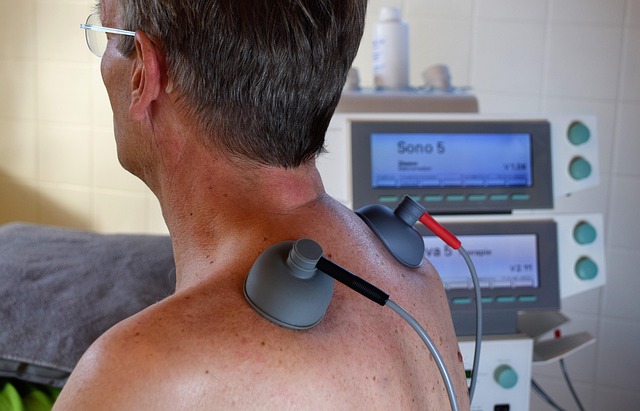Red Light Therapy (RLT) and Cryotherapy are non-invasive pain management solutions. RLT uses red light to stimulate cellular repair, boost circulation, and reduce inflammation for chronic muscle pain, while cryotherapy employs extreme cold to constrict blood vessels and provide instant relief from acute injuries and soreness. RLT offers long-term healing and collagen production, whereas cryotherapy excels in short-term pain interruption. When choosing between them, consider time commitment, accessibility, potential side effects, and personal preference for sore muscle relief.
Experience pain relief without drugs or downtime? Red light therapy (RLT) and cryotherapy are gaining popularity as alternative treatments. RLT uses specific wavelengths of light to penetrate tissues, stimulating cell repair and reducing inflammation for sore muscles. Cryotherapy involves cold therapy, constricting blood vessels to numb areas and reduce swelling. This article delves into the mechanics of both methods, compares their benefits, and guides you in choosing the right pain relief approach for your needs, focusing on RLT’s role in soothing sore muscles.
Understanding Red Light Therapy for Sore Muscles
Red Light Therapy for Sore Muscles has gained significant attention as a non-invasive approach to pain relief. This therapy involves exposing the affected area to red light at specific wavelengths, believed to stimulate cellular repair and boost circulation. By increasing blood flow, red light therapy aims to reduce inflammation and ease muscle soreness associated with injuries or overtraining. The gentle heat generated by the light can also help relax tight muscles and promote faster healing.
For athletes or individuals suffering from chronic muscle pain, red light for sore muscles offers a promising alternative. It is thought to enhance the production of collagen, a protein crucial for tissue repair and elasticity. With regular sessions, users may experience improved flexibility and reduced recovery time between intense workouts or physical activities. This method’s non-invasive nature makes it an attractive option, especially as a complement to other therapeutic treatments.
The Mechanics of Cryotherapy and Its Effectiveness
Cryotherapy, or cold therapy, involves exposing the affected area to extreme cold temperatures, typically through ice packs or liquid nitrogen. This treatment works by constricting blood vessels, which reduces blood flow and inflammation in the injured or sore muscles. The sudden cold also acts as a numbing agent, providing temporary pain relief. This mechanism is particularly effective for acute injuries, sprains, strains, and muscle soreness. Over time, cryotherapy can aid in healing by promoting the formation of new, stronger tissue and reducing scar tissue. Many athletes use this method to recover from intense workouts or competitions, as it helps alleviate post-exercise muscle pain and speeds up recovery.
While red light therapy for sore muscles has gained popularity as a holistic approach to wellness, cryotherapy offers a different but equally powerful way to manage pain. Its effectiveness lies in its ability to swiftly interrupt the body’s pain signals and reduce inflammation, making it a go-to choice for rapid relief. However, it’s essential to remember that both treatments have their unique advantages and may be more suitable for specific conditions or preferences.
Comparing Benefits: Red Light vs. Cryotherapy
When it comes to alleviating pain and promoting muscle recovery, both red light therapy (RLT) and cryotherapy have gained popularity as innovative approaches. One key comparison lies in their mechanism of action; RLT uses specific wavelengths of red light to penetrate the skin and stimulate cellular repair processes, while cryotherapy involves cold temperatures to reduce inflammation and numb affected areas. For individuals seeking relief from sore muscles, RLT offers a non-invasive option that can increase circulation and reduce muscle stiffness without the extreme cold experienced during cryotherapy sessions.
The benefits of red light for sore muscles are supported by growing research, indicating its potential to accelerate tissue repair and enhance collagen production. In contrast, while cryotherapy is effective in providing short-term pain relief, it may not target deep muscle tissues as directly as RLT. This distinction makes red light therapy an appealing choice for long-term muscle recovery and management of chronic conditions characterized by muscular discomfort.
Considerations for Choosing the Right Pain Relief Method
When deciding between red light therapy and cryotherapy for pain relief, several considerations come into play. Both methods have their unique benefits, targeting different aspects of pain management. Red light therapy, also known as low-level laser therapy (LLLT), is a non-invasive approach that uses specific wavelengths of light to stimulate cellular repair and reduce inflammation in sore muscles and joints. It’s particularly effective for chronic muscle pain and has been shown to enhance recovery after workouts or injuries.
On the other hand, cryotherapy involves exposure to extreme cold, usually in the form of ice baths or compressed air, to constrict blood vessels and reduce swelling. This method is especially useful for acute injuries or post-workout soreness, as it provides a rapid cooling effect that numbs the affected area, alleviating pain instantly. However, it’s crucial to consider factors like time commitment, accessibility, potential side effects, and personal preference when choosing between these two effective pain relief methods.
Red light therapy and cryotherapy both offer effective pain relief, but each has unique benefits. Red light therapy stimulates cellular repair and reduces inflammation, making it ideal for chronic muscle soreness. Cryotherapy, on the other hand, provides rapid short-term pain alleviation through cold exposure. The choice depends on individual needs: if seeking long-term muscle recovery, red light therapy is preferable. However, for acute injuries or instant relief, cryotherapy might be more suitable. Understanding these methods allows folks to make informed decisions for their specific pain management requirements, leveraging the power of both therapies for optimal results.
